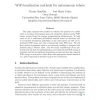3955 search results - page 122 / 791 » Comparing the Power of Robots |
ICCAD
2001
IEEE
15 years 6 months ago
2001
IEEE
1 - This paper presents an efficient design exploration environment for high-end core processors. The heart of the proposed design exploration framework is a two-level simulation e...
AAAI
2008
15 years 10 days ago
2008
In multi-robot settings, activity recognition allows a robot to respond intelligently to the other robots in its environment. Conditional random fields are temporal models that ar...
CEC
2010
IEEE
14 years 10 months ago
2010
IEEE
Abstract— In Evolutionary Robotics (ER), explicitly rewarding for behavioral diversity recently revealed to generate efficient results without recourse to complex fitness funct...
JISE
2007
14 years 10 months ago
2007
stems. Three layers of control abstraction for formation control are formation shape, reference type, and robotic control. Reference types play an important role in formation contr...
ROBOTICA
2006
14 years 10 months ago
2006
This paper compares two methods to estimate the position of a mobile robot in an indoor environment using only odometric calculus and the WiFi energy received from the wireless co...

